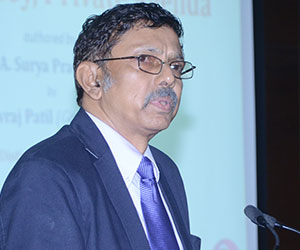The last fortnight has seen an intense debate over the unfortunate happenings in some university campuses including Jawaharlal Nehru University (JNU) and Jadavpur, where some students raised anti-national slogans, challenged the unity and integrity of India and mocked at the Union Government’s decision to hoist the national flag in all central universities.
Many of those participating in this shrill debate on television channels and campuses displayed a visceral hatred for a duly elected government at the Centre and in order to spite it, took the Pakistani line on the Kashmir issue and even went to the absurd extent of describing the national tricolour as a “Hindu Flag”.
Though these are fringe elements which are electorally irrelevant, they need to be challenged because of the disproportionate media space they occupy and the distorted image of India that they are peddling outside the country.
Tragically, these so-called “Professors” who teddle such gibberish about the national flag need to be educated on the history of the flag, almost seven decades after we won our independence and adopted it.
The observations of Dr.S.Radhakrishnan, philosopher and former president and a great mind that guided India during the traumatic phase of partition and freedom, on the national flag should be compulsory reading for these malcontents in our politics and academia.
Dr.Radhakrishnan’s opening remarks in the Constituent Assembly in July, 1947 at the time of adoption of the flag were indeed prophetic. It was as if he was addressing the nation after listening to the recent cacophonous debate on nationalism and the national flag and desperately trying to instill some sense into those who were questioning the need for the tricolour in our universities. He said: “What is essential today is to equip ourselves with new strength and new character……if the country is to achieve the great ideal of unity and liberty which it fought for……Times are hard. Everywhere we are consumed by phantasies. Our minds are haunted by myths. The world is full of misunderstandings , suspicions and distrusts. In these difficult days it depends on us under what banner we fight”
He then went on to explain the deep meaning that every aspect of India’s flag carried. He said the white band at the centre represented the path of light….the ideal light, the light of truth, of transparent simplicity. The Asoka Chakra in the middle represented the wheel of Dharma. “The wheel is perpetually revolving….there is life in movement. Our Dharma is Sanatana, eternal. Its uninterrupted continuity is its Sanatana character”.
The Bhagwa or saffron band at the top represents the spirit of renunciation. “All forms of renunciation are to be embodied in Raja Dharma. Philosophers must be kings. Our leaders must be …..people who are imbued with the spirit of renunciation which that saffron colour has transmitted to us from the beginning of our history….(It) stands for the fact that the world belongs not to the wealthy…..but to the weak and the humble, the dedicated and the detached”.
The green band he said reminded us of our relation to the earth and plant life. We must build our paradise here on green earth and in order to do so, ”we must be guided by truth (white), practice virtue (the wheel), adopt the method of self-control and renunciation(saffron)”.
In conclusion, he said; The flag tells us “Be alert, be ever on the move, go forward, work for a free, flexible compassionate, decent, democratic society in which the Christians, Sikhs, Muslims, Hindus and Buddhists will all find a safe shelter”. The entire assembly responded with loud cheers when Dr.Radhakrishnan concluded his speech.
Jawaharlal Nehru, who moved the resolution for adoption of the national flag said: “It is a Flag which has been variously described. Some people, having misunderstood its significance, have thought of it in communal terms and believe that some part of it represents this community or that. We thought of a design for a Flag…..which would represent the spirit of the nation, the tradition of the nation….through thousands of years. So, we devised this flag. A nation, and especially a nation like India with an immemorial past, lives by other things also, the things of the spirit. If India had not been associated with these ideals and things of the spirit during these thousands of years, what would India have been?
Nehru also spoke of how the Congress Party’s flag formed the basis for designing the national flag. The Charka in the Congress Party’s flag had been replaced by the Asoka Chakra.
Several other members of the Constituent hailed the flag. Mr.Mohomed Sheriff said the white, saffron and green in the flag signify purity, renunciation and sacrifice, have great spiritual significance and these colours are venerated by all –Hindus,Muslims, Christians and Parsis. Further, the design was aesthetic and suited the genius, tradition and culture of India.
Saiyid Mohammad Saadulla welcomed the inclusion of saffron in the flag and said it reminded the people that they must keep themselves on the “high plane of renunciation”.
Mr.Frank Anthony, who served on the Flag Committee of the Constituent Assembly said the flag did not contain any communal motives or significance. It was “a beautiful flag in its physical aspect and also in its motives”.
The best way to shame those who attribute other motives to the colours of our national flag is to cite the opinions of these learned individuals who designed our flag almost seven decades ago.
It is sad to see people run down the national flag, which ought to be treated with the utmost reverence because it brings all Indians together and is therefore the most secular point of convergence. In a diverse nation such as India where every symbol, flag and book is seen as being denominational and divisive, two things that bring all citizens together is the national flag and the Constitution of India. Therefore, any attempt to denigrate the flag not only violates a specific law such as the Prevention of Insults to National Honour Act and the Flag Code but also strikes at the most sacred secular symbol of India.
Given this history of the flag and the deep connect the Congress Party has with it, it was indeed shocking to see members of India’s oldest party team up with the communists and a frustrated bunch of politically displaced academicians to mock at the idea of hoisting the tricolour in our university campuses. Is this really the party that fought for India’s freedom?
Published Date: 10th March 2016, Image Source: http://scoopnews.in
(Disclaimer: The views and opinions expressed in this article are those of the author and do not necessarily reflect the official policy or position of the Vivekananda International Foundation)










Post new comment